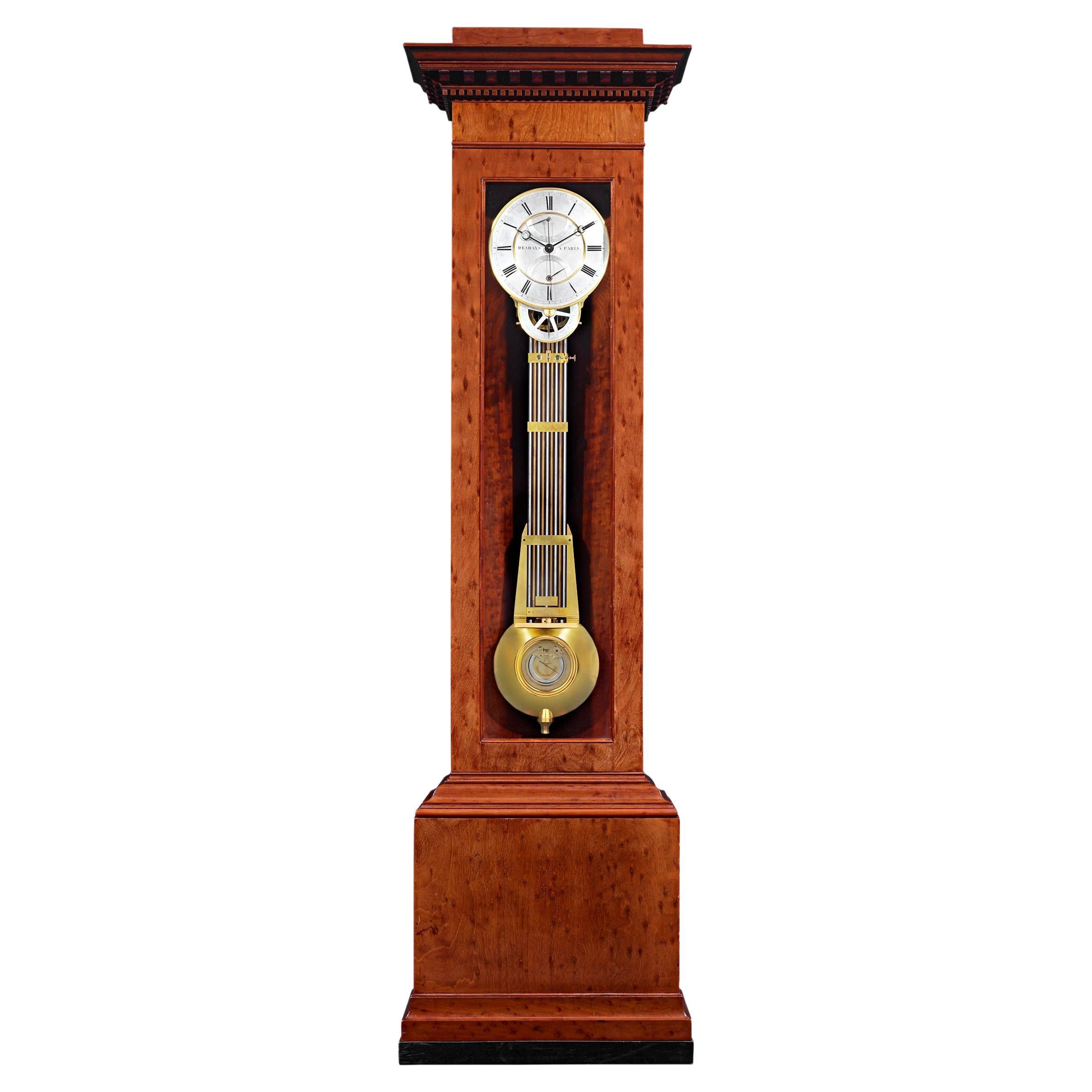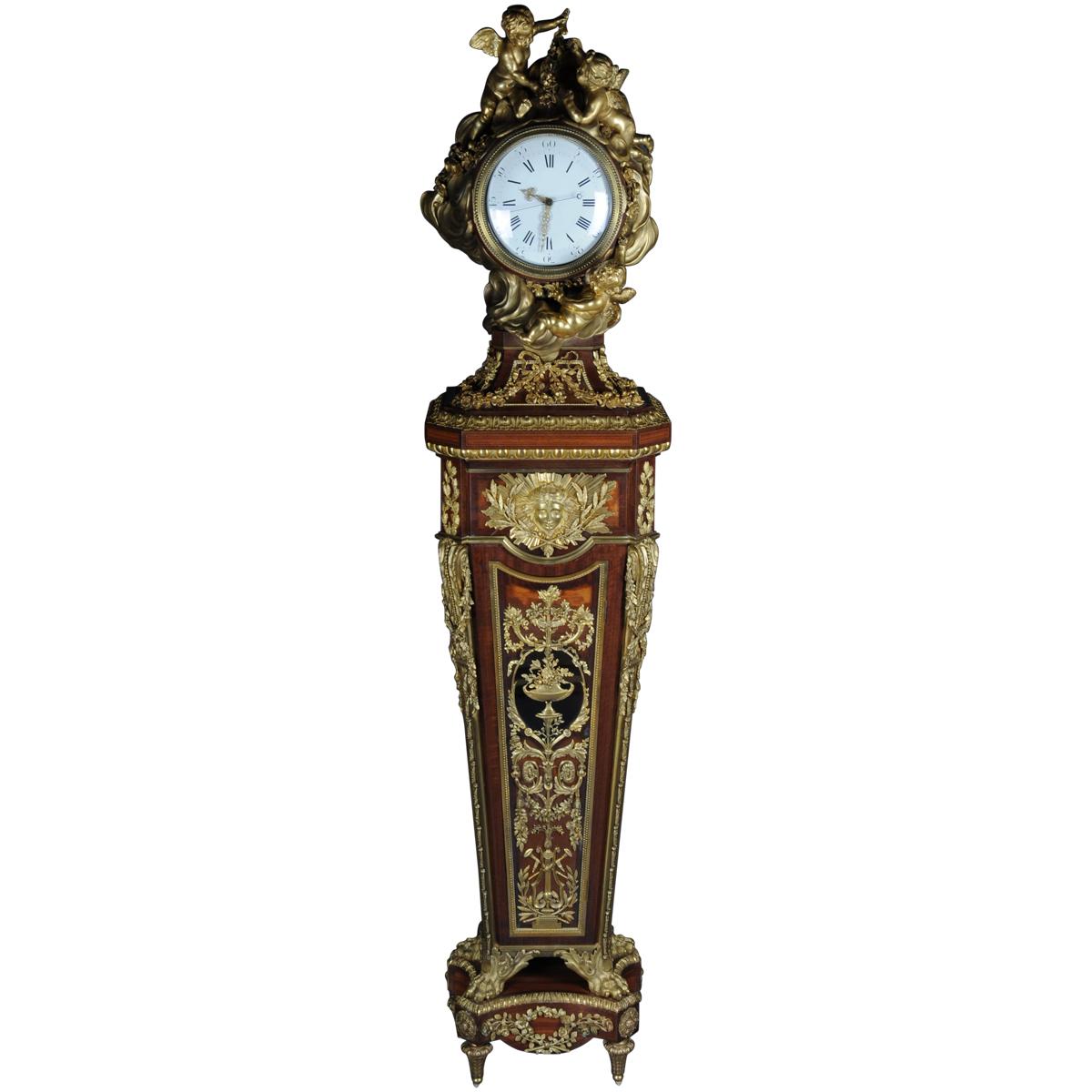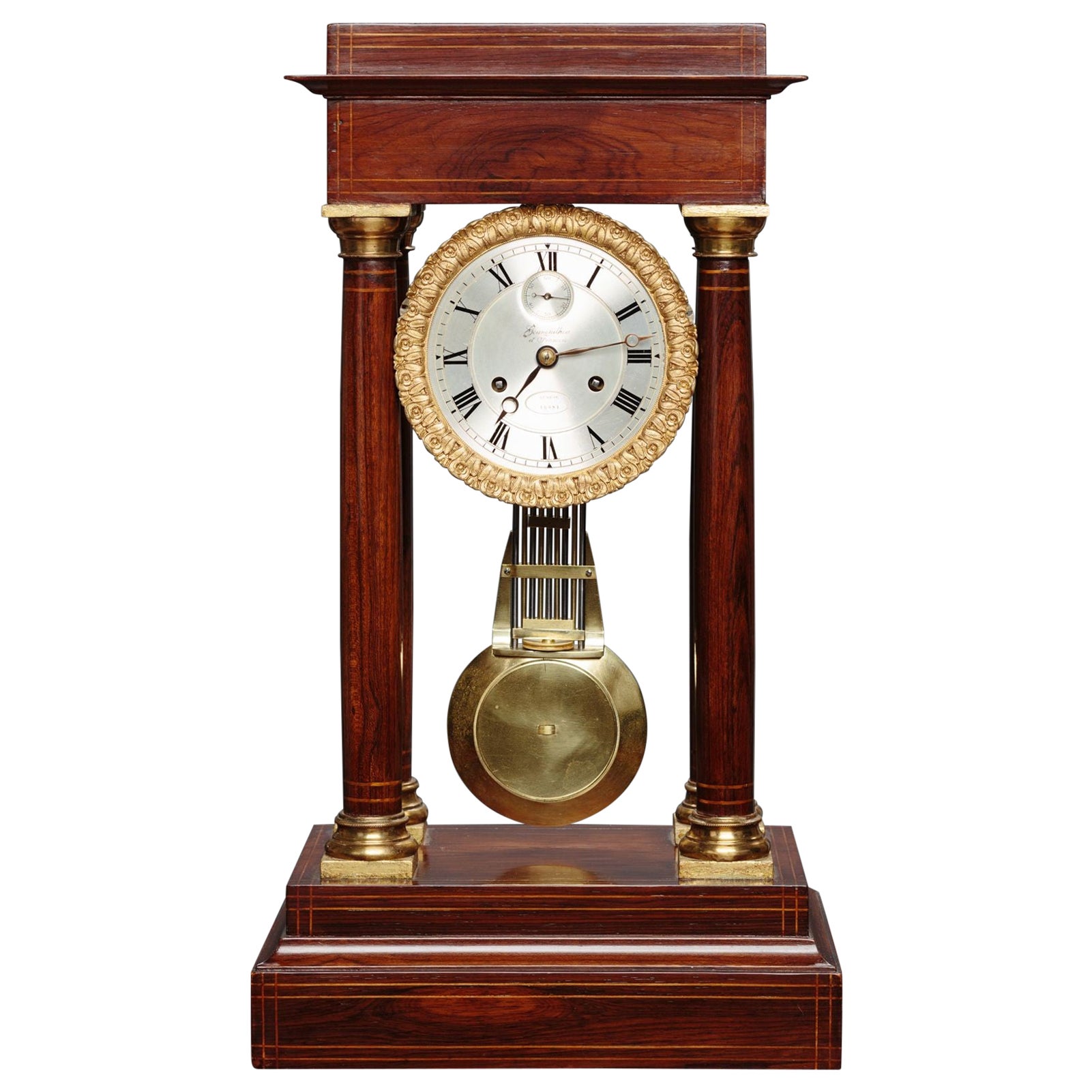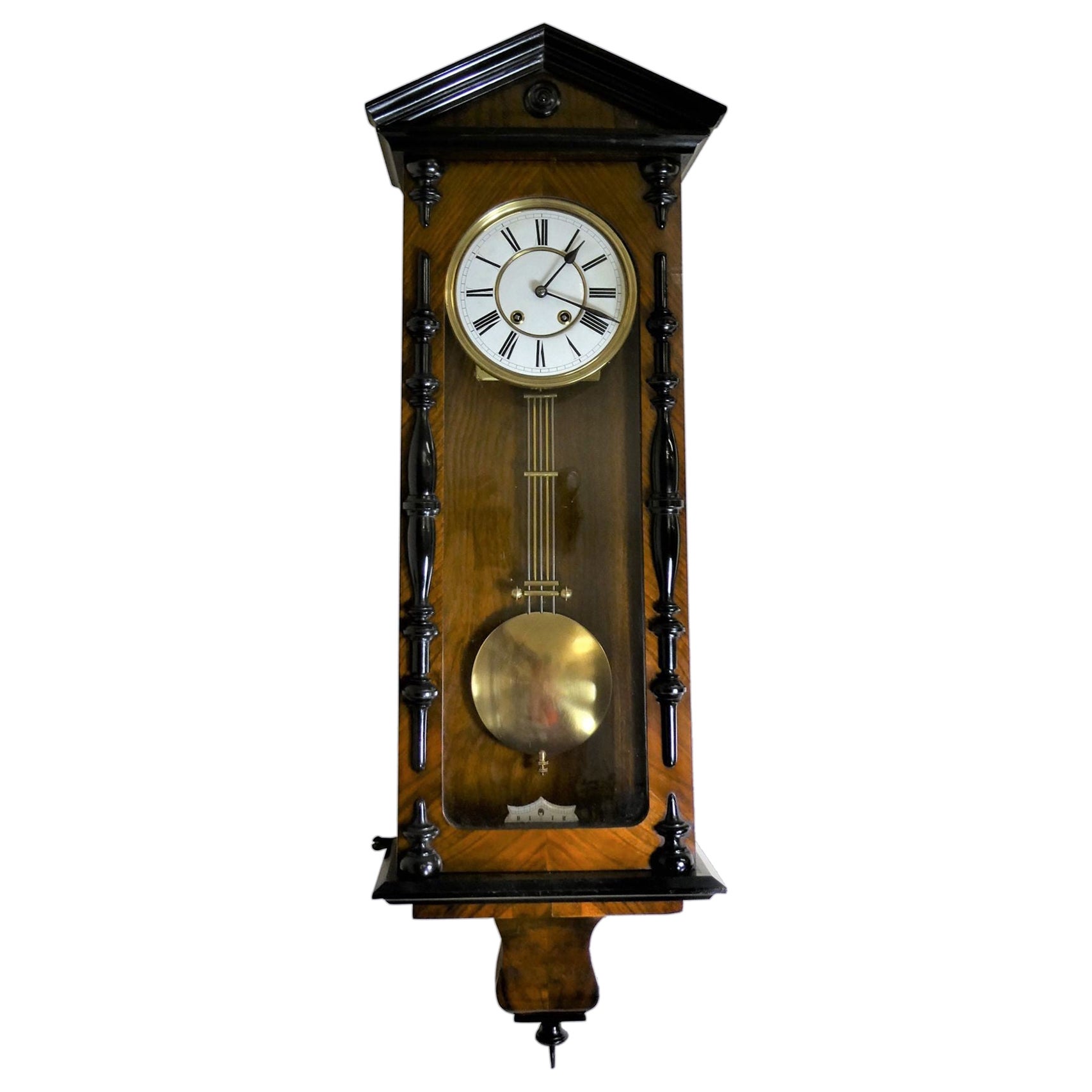Items Similar to Regulator Clock by Jean-Aimé Jacob and Adam Weisweiler
Video Loading
Want more images or videos?
Request additional images or videos from the seller
1 of 8
Regulator Clock by Jean-Aimé Jacob and Adam Weisweiler
About the Item
This important regulator clock beautifully demonstrates the heights of precision clockmaking. While regulator clocks are known for their incredible accuracy, this timepiece is truly exceptional in its mechanical proficiency. Crafted and signed by Jean-Aimé Jacob, one of the most important French horologists of his age, the clock features a weight-driven movement with a deadbeat, or “Graham” escapement, the most accurate escapement that is still used to this day. Its ingenious construction eliminates the recoil, and therefore the inaccuracy, of the more common anchor escapement.
While most regulator clocks were created purely for function rather than aesthetics, this timepiece is set apart by its equally important case. Crafted of rare plum pudding mahogany, the case is attributed to the atelier of Adam Weisweiler, one of the foremost ébénistes of the Louis XVI period. The German-born cabinetmaker is best remembered for his neoclassical creations that were beloved by the French court, including Queen Marie-Antoinette, the king of Naples and England's Prince Regent (later George IV). Not only did he use the finest of materials, but his craftsmanship also showed a remarkable level of precision and proportion that is perfectly displayed in this clock case. The incorporation of ebony and gilded accents is also typical of his work, and here both materials beautifully complement the rich texture and mottled finish of the plum pudding mahogany.
After his retirement, his son Jean oversaw Weisweiler’s atelier until 1844. This clock case typifies the ebony and gilded neoclassical aesthetics made popular by his father that prevailed during the last decades of the Ancien Régime. Today, Weisweiler’s furniture can be found in all of the most important museums around the world, including the Metropolitan Museum of Art (New York), the J. Paul Getty Museum (Los Angeles), the Royal Collection Trust (London), the Museum of Fine Arts (Boston), the Philadelphia Museum of Art and many others.
Once primarily found in prominent public and government buildings, regulator clocks have been the most accurate of the weight-driven clocks since their inception in the mid-18th century. Because of the expense to create them and their primary duty of being the keepers of time by which other clocks would be calibrated, relatively few regulator clocks were ever made, as evidenced by the small number of antique specimens that exist today. This fact, in conjunction with its incredible mechanism and overall workmanship, makes this regulator a true mechanical marvel.
Circa 1830
22 3/4" wide x 12 5/8" deep x 84 1/2" high
- Dimensions:Height: 84.5 in (214.63 cm)Width: 22.75 in (57.79 cm)Depth: 12.63 in (32.09 cm)
- Style:Louis XIV (In the Style Of)
- Materials and Techniques:
- Place of Origin:
- Period:
- Date of Manufacture:circa 1830
- Condition:
- Seller Location:New Orleans, LA
- Reference Number:
About the Seller
5.0
Recognized Seller
These prestigious sellers are industry leaders and represent the highest echelon for item quality and design.
Established in 1912
1stDibs seller since 2010
93 sales on 1stDibs
Typical response time: 7 hours
- ShippingRetrieving quote...Ships From: New Orleans, LA
- Return PolicyThis item cannot be returned.
More From This SellerView All
- Month-Going Regulator Clock by Deshays à ParisLocated in New Orleans, LAThis Louis-Philippe-period month-going longcase regulator clock is an exceptional example of French clockmaking, and its complicated mechanism marks several different aspects of passing time. Crafted by Deshays à Paris, the timepiece displays sleek silvered steel dials that indicate the time, date, month, equation of time...Category
Antique 19th Century French Louis Philippe Grandfather Clocks and Longca...
MaterialsSteel
- James Condliff Skeleton Table Regulator ClockLocated in New Orleans, LAA horologic masterpiece of precision and beauty, this Victorian-era skeleton clock is an extraordinary example of 19th-century British clockmaking by the famed James Condliff of Liverpool. Regarded as the father of the English skeleton clock...Category
Antique 19th Century English Victorian Mantel Clocks
MaterialsBrass
- Louis XVI Style Grand Regulator ClockLocated in New Orleans, LAThis monumental longcase regulator clock crafted in the resplendent Louis XVI style is both a marvel of horological innovation and a paragon of arti...Category
Antique 19th Century French Louis XVI Grandfather Clocks and Longcase Cl...
MaterialsEnamel
- Breguet Month-Going Long Case Regulator ClockLocated in New Orleans, LACompleted on December 31st, 1931, this Breguet mahogany and brass floor month-going regulator clock is a perfect emblem of Breguet’s Art Deco and mechanical excellence during the important interwar period. Adorned with the hallmark Breguet features, including the famous moon tip Breguet hands and a beautifully polished brass frame, the clock is further enhanced with exquisite decoration on the plates. Featuring the most accurate escapement of its time, this month-going regulator stands as one of the most dependable timekeepers of its day. Its design even excludes a chime to...Category
20th Century Swiss Art Deco Grandfather Clocks and Longcase Clocks
MaterialsBrass
- George III Adam and Eve Automaton Longcase ClockBy James FentonLocated in New Orleans, LAA majestic specimen of English clockmaking, this important longcase clock by London clockmaker James Fenton features an exceptional Adam and Eve automaton above the dial. Longcase ti...Category
Antique 18th Century English George III Grandfather Clocks and Longcase ...
MaterialsMahogany
- Louis XVI Marble Mantle Clock by Jean-Nicolas SchmitLocated in New Orleans, LAA horologic masterpiece of precision and beauty, this neoclassical marble and ormolu mantle clock is an extraordinary example of late 18th-century French clockmaking by the famed Jea...Category
Antique 18th Century French Neoclassical Mantel Clocks
MaterialsMarble, Ormolu
You May Also Like
- American Eastlake Oak Regulator Clock by GilbertLocated in Montreal, QCClassic Gilbert #12 regulator in Eastlake oak long case with floral and foliate carved band running under cornice and over a row of incised decoration; with brass ringed clock face f...Category
Antique 19th Century American Eastlake Clocks
MaterialsMetal, Brass
- George III Mahogany Regulator ClockLocated in Bradford-on-Avon, WiltshireA Regulator clock by William Chisholm, London. Baillie has no record of the maker but by the design of its original case, we believe it to be late 18th century circa 1790. The 8 day ...Category
Antique 1790s English George III Grandfather Clocks and Longcase Clocks
MaterialsMahogany
- Napoleon III Pedestal Clock “Parquet Regulator” after Jean-Henri Riesener, 1734Located in Berlin, DEA Model of Jean Henri Riesener (Received Master in 1768) executed in 1785. (inv. OA 5501 In Louvre Museum). 19th Century. This fine and sumptuous “Regulateur de Pendule” presents a fine amaranth. Of Sycamore oeuil de vermeuil, ebony and buis stringing marquetry. The base and the gaine are decorated with diamond shapes. The hours are inscribed in Roman numerals and the munutes in Arabic. It takes place in a magnificent gilt décor of three winged children playing with garlands on clouds. The regulateur is enriched with a delicate garniture of bronze. The dial and each panel are framed by an elegant frieze of palms and pearls. The top of the gaine is enhanced with a frieze of palms and ovums, foliages and garlands of flowers. Each corner is ornated with fleurons. The front of the gaine is embellished by an Apollo mask (Sun Symbol) and each side with laurel crowns. Under the mask the cartouche is decorated by a stylized vase of flowers. Foliated scrolls, flowers, garlands, cornucopias and musical instruments such as a harp (Apollo Reference) the cherubs are underlined by pearls, scrolls of Acanthus Leaves and garlands dawning out in foliages, framed with ropes until the lions feet. The feet rest on a base ornated with fleurons and foliages with buds of flowers ending in four conical feet with acanthus leaves. With André-Charles Boulle (1642–1732) and Charles Cressent (1685–1768), Riesener was arguably one of the three greatest French ébénistes of the 18th century. Eventually taking over the workshop after Oeben's death in 1763, and marrying his widow some four years later. He is renowned for completing the famous bureau du Roi...Category
Antique Late 19th Century French Napoleon III Grandfather Clocks and Lon...
MaterialsBronze
- Rosewood Portico Regulator Mantel ClockLocated in Norwich, GBRosewood Portico Regulator Mantel Clock Housed in a fine quality Rosewood portico case with boxwood stringing, turned pillars with brass capitals, gilded cast foliate bezel and stan...Category
Antique 1840s Swiss Mantel Clocks
MaterialsRosewood
- Victorian Walnut and Ebony Vienna 'Regulator' Wall ClockLocated in Norwich, GBVictorian Walnut and Ebony Vienna ‘Regulator’ Wall Clock Victorian Vienna ‘Regulator’ wall clock housed in a walnut case with ebony mould...Category
Antique 1890s Victorian Wall Clocks
MaterialsWalnut
- French mahogany regulator 'portico' mantel clock by MontassierLocated in HAARLEM, NLThe clock movement is suspended from a portico within four pillars. The mahogany case is decorated with extremely beautiful cast and gilded bronzes, including two griffons facing an ...Category
Antique 19th Century French Empire Mantel Clocks
MaterialsBronze





